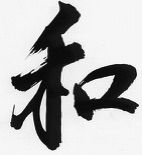BEHAVIOUR IN THE DOJO
The six rules for the practiser.
LOOK AT YOUR FEET
Before entering the dojo we must check our clothing and mentally prepare for the training session. The habit of thinking that training begins the moment we enter the dojo is very important. A person who has this attitude will not only leave their shoes tidily outside but will also tidy up other people’s shoes. One must take particular care of ones’ feet and of their cleanliness. The keiko must always begin by desiring to put something which is close to us in order. How can you do something important without first succeeding in the little, everyday things?
THE GREETING-REI
The greeting, Gasso, is correct for any occasion. There is a Japanese rule that establishes that human relationships must always begin and end with courtesy. Good manners are needed to correct attitude, to balance and to put one’s thoughts in order immediately. A composed mind gives a person dignity and as a consequence his or her greeting is dignified and solemn albeit fully alert. When Gasso is performed properly it avoids conflict and with it one can also control the enemy without fighting.
Martial art is practised as a method of spiritual development. All physical and spiritual aspects must be unified and all manners must show respect, love and spirit of compromise.
Therefore, the only manner is Gasso. Gasso is both a combat position and the demonstration of the greatest form of respect between two people.
CLEANING THE DOJO
All practisers must take part in cleaning the dojo and nobody must stand back and watch. Do the cleaning willingly and remember that this aspect is also part of the training session as you are perfecting and cleaning up your own minds. The place where training is held must be pleasant and where everybody is at ease.
CLOTHING
Be aware of your clothing. It is not necessary to dress with exaggerated care or wear expensive clothes but tidiness, cleanliness and moderation are imperative. Avoid bulkiness.
ATTITUDE
The preferred attitude is courteous, attentive and moderate. When listening to the instructions during the lesson let us watch the Master in Kaisho Jai No Kamae, our hands should be open, the right hand in the left and thumbs crossed – the right one over the left.
Our arms should be placed in a natural position before the belly, our bodies in a natural position and our backs straight as we stand in the Musubi Dachi or in the Heisoku Dachi positions.
WAY OF SPEAKING
Use richness of terms and correct and dignified words. Never raise your voice and speak in an even rhythm. Using vulgar expressions means one has very little interior wealth. The practiser must know how to “cleanse” him- or herself and seek transparency of expression from within.
RULES FOR THE PRACTISER
Every practiser must make a moral committment not to use Karate-do Shotokai with the intention of injuring or as an expression of his or her ego.
Karate-do Shotokai taught in the K.I.S.A. Dojo is not meant to destroy but indeed it is meant to improve society by means of one’s own personality.
The Dojo is not a place for avenging one’s personal conflicts. Karate-do is not a street fighting art. You are in the Dojo to transcend and purify your aggressive reactions.
Competitiveness must not exist in the K.I.S.A. Dojo. Our practice does not have the purpose of beating an adversary.
The power of Karate-do Shotokai does not lie in muscular power but in fluidity, in the search for total energy, in the study of Irimi and communication, in the control of oneself and in humility.
Every form of insolence will be blocked. Everyone must be aware of their own limitations.
Everyone has physical possibilities and different reasons for practising Karate-do Shotokai, and these must be respected.
True Karate-do Shotokai is the correct and fluid application of the most appropriate technique for every occasion.
You must be very careful not to inflict injuries. You must protect your partner and yourself.
You must graciously accept the advice and suggestions offered to you by the Senseis / Masters and by the Sempais and try to apply them sincerely, in the best way possible. There is no room for protest.
You must respect the old practisers (the Sempais) which you yourselves will become, as you do the Senseis, because they are the bearers of technical experience.
All practisers study the same principles. There must be no discrepancies within the group nor among any of the practisers in the Dojo as we make up one big family.
Karate-do teaches us to seek health by keeping it and strengthening is so as to live long, harmonious and well-balanced lives.
The abuse of alcohol and smoke must be avoided while it is severely prohibited to use drugs as these alter our psychological and physical balance.
We must eat healthily preferring lots of fruit, vegetables and cereals and take small amount of food deriving from animals as this keeps our bodies and minds healthier and we can practise Karate-do Shotokai better.
The secret of our practice is harmony. If you are unable to respect these rules you will never be able to learn Karate-do Shotokai.


